Vital Animal News: December 29, 2024
Pet Obesity II / Bird Flu in Cats? Oh oh. / EO Certification Training / Tasty Tips: Safe Food / and MORE
Pet Food to Fix Pet Obesity?
Cats, Cows, and Bird Flu, Oh My
Aromatherapy Training
Tasty Tips: Know Your Farmer!
Along the Natural Path
Is Rx Pet Food the Answer?
[In case you missed it, the last issue of Vital Animal News had part 1 of this important discussion on obesity]
In a very brief review:
Carbs make one hungry (one means a dog, a cat, or you)
Carbs push the blood sugar skyward
Insulin rushes in to lower it
When the spike and drop in blood sugar takes place over and over (as it does in the SAD and most pet feeding scenarios based on kibble), insulin resistance sets in (estimates: 80% of people in the US have it now)
That means insulin fails in its job to get the blood sugar under control
IR also means insulinemia: high blood levels of insulin remain, as it tries and tries to do its job
Insulin is a growth hormone, in simple terms. It’s all about anabolism, build up.
Unlike most hormones, it affects almost every cell in the body, including the fat cells.
—>Too many carbs + too much insulin = fat bodies, in pets or their peeps.
The Big O
If your conventional veterinarian has brought up the dreaded O Word (probably the milder version “overweight,” as obesity just has too much angst clinging to it) odds are the solution you’ve been sold is a prescription diet.
This is, well, a unique marketing perspective, begun by Hill’s, the makers of Science Diet.
In this case, one Hill’s Rx food is called “Metabolic Chicken Flavored Dog Food,” and the ingredient list is worth a deeper look:
Whole Grain Wheat, Whole Grain Corn, Chicken Meal, Powdered Cellulose, Soybean Meal, Corn Gluten Meal, Dried Beet Pulp, Dried Tomato Pomace, Hydrolyzed Chicken Flavor, Chicken Fat, Flaxseed, Coconut Oil, Lactic Acid, DL-Methionine, L-Lysine, Carrots, Potassium Chloride, Iodized Salt, Lipoic Acid, vitamins (Vitamin E Supplement, L-Ascorbyl-2-Polyphosphate (source of Vitamin C), Niacin Supplement, Thiamine Mononitrate, Vitamin A Supplement, Calcium Pantothenate, Riboflavin Supplement, Biotin, Vitamin B12 Supplement, Pyridoxine Hydrochloride, Folic Acid, Vitamin D3 Supplement), Choline Chloride, minerals (Manganese Sulfate, Ferrous Sulfate, Zinc Oxide, Copper Sulfate, Calcium Iodate, Sodium Selenite), Taurine, L-Carnitine, Mixed Tocopherols for freshness, Natural Flavors, Beta-Carotene.
Carbs: Cheap and Sweet
Notice the first two ingredients?
Both wheat and corn are subsidized crops in the US (along with soybeans) so: dirt cheap.
As with human foods, the order of ingredients on a pet food label indicates the quantities in the final product, from greatest to least.
So, two carbs in the top two places, then the protein source, rendered chicken. (Ewww: rendered anything is not something friends feed friends!)
“Chicken meal” is undoubtedly cheaper than starting with real chicken, but it’s those carbs that will spur the pancreas to send out insulin, to try to control the blood sugar spikes that follow carb intake.
And, as we know from last issue, blood sugar spikes are the basis for weight gain, obesity and metabolic disease.
So, we’re not off to a great start here in our quest to control obesity with a prescription diet…
Wait: Powdered Cellulose??
Yeah, that’s fiber, you know? You may not know the source though: wood pulp.
The thought is the fiber fills one up, makes you eat less, so might it be a cure of obese pets, coming there in Ingredient #4?
Okayyyy…
Beet pulp, ditto, fiber left overs from sugar beets after the sugar is taken out.
And, my bad, I used to call out corn gluten meal as a sweet, but it’s actually protein, after the nasty high fructose corn syrup (perhaps the chief obesity source in the US) has been extracted.
Just a highly processed protein compared to, say, a blob of hamburger or an egg cracked into Sadie’s dish.
Missing: Satiety’s Best Friend: Good Fats!
What beats fiber for that glorious state of satiety (“Hey. I’m full. Moving away from that food bowl now, thanks Mom!”)?
FAT!
Double edged source, so probably deserves an article of its own someday.
Good fats: butter, coconut oil, olive oil (fine for you at home, but less stable in manufactured pet food…), lard, avocado oil
Bad fats: unless you’ve been living under a rock, you’ll have read about “seed oils” and their nasty nutritional consequences.
Bottom Line: You Can Do Better!
More carbs aren’t going to fix obesity, even if they are rubbing shoulders with lots of fiber.
And never let labels like this scare you away from thinking you can make your own pet food, and wayyyy better pet food than anything in a bag or a can!
Think wolf. Think bobcat. Think what prey would look like.
Muscle
Organs
Bones
No byproducts of any kind, no ingredients you can’t pronounce, and you’d have to admit: those wild cousins are Doing. Just. Fine.
Obese wolves? Nope. Diabetic bobcats? Unheard of.
p.s. I just learned my friend Megan Redshaw has further red flags about Ozempic’s horrible side effects, in case my last issue hasn’t convinced you that the feline version is to be avoided at all costs.
Bird Flu Update

It seems the feline world is very challenged by this bird flu virus.
Aside from the question nobody seems to be asking, “How are cats now susceptible to an avian virus?” and the likely answer: Gain of Function (GoF) research, funded by you and I…
We are facing the reality that cats of all stripes are trouble.
Big Cat Deaths
A number of big cats were lost in a Washington state sanctuary, some 20 cats dying just since Thanksgiving.
Wild Felid Advocacy Center in Shelton has been sheltering tigers, cougars, bobcats and others for 20 years.
The big cats come from abuse cases, negligence, or as an alternative to euthanasia, and Shelton becomes their “forever home.”
They have 4 sick cats now (expected to survive) and one critically ill. Twelve big cats have had no symptoms at all.
The facility is quarantined now to hopefully contain the outbreak.
Although the source of the HPAI virus is unknown, they have dumped thousands of pounds of meat and the owner expects their losses to be upwards of $150,000 by the time this is over and they are able to reopen to the public.
The news story here has a link for donations, if you are interested. [A heads up: if your browser has a “Reader” function, use it to avoid the news site’s many ads].
Small Cats, Too
The USDA is keeping track of wild mammals succumbing to this virus, and domestic cats are among the species showing up (black square icons:
The association of cows and cats is borne out by data:
So far, at least 52 cats have tested positive for avian influenza virus type A (H5N1) in states where the virus also has been found in dairy cattle. — AVMA — updated Dec 23, 2024
As far as deaths, as of this writing, that number is “at least eleven confirmed deaths from H5N1 in cats have been documented in Poland, alongside additional cases in the U.S. totaling at least seven deaths across various reports.” My search parameter: https://kagi.com/search?q=how+many+cases+of+H5N1+definitively+proven+to+kill+cats&r=us&sh=718L5ifWwzXtvzP5sDcs4Q
Two of the latest cat deaths were in Los Angeles, “after consuming contaminated raw milk.”
So, it appears cats are uniquely susceptible while dogs are not, at least in this data set.
The source of the virus in cats has been posited to be contact with wild birds, raw food (poultry based), and raw milk and colostrum.
Cat Symptoms of H5N1
This is from the AVMA, but similar reports are circulating:
Illness may start with loss of appetite, lethargy, and fever, then quickly progress, with cats exhibiting:
Neurologic signs (e.g., ataxia, circling, tremors, seizures, or blindness)
Severe depression
Copious oculonasal discharge (eyes and nose)
Other respiratory signs, including tachypnea(rapid breathing), dyspnea(difficult breathing), and possibly sneezing or coughing”
They rightly note that rabies could exhibit similar neurologic signs, so if you’re unlucky enough to have a cat showing these symptoms, it’ll be best to avoid bites and saliva. Call your public health officials as linked in this same page (AVMA).
Cows Have Adapted
As we learned pretty quickly in vet school, species differ in all sorts of ways beyond appearance.
You may remember cows started showing up with this disease in March, in Texas.
It appeared to transmit cow to cow, and cow to human.
The cows didn’t die, but went off their feed and dropped in milk production.
As the months have gone on, it appears they’re now more likely to be “asymptomatic” while carrying the virus, which is hopeful, right?
That means they are not sick, but only tested positive.
So, while cats are clearly having a horrible time with this same virus, dying even, cows are fighting it off and not even showing the symptoms they once did.
This is the way it’s supposed to be, by the way. If a virus (or parasite, bacteria, insect, etc.) kills off its host animal, it’s just lost the game of life. Dead end, right?
So, if we can learn more about how cows responded to the H5N1 baddie, maybe we can help other species beat it as well.
Breaking News: Cat Food Recall after (1) Cat Death
As I was writing this up, into my inbox popped a voluntary raw cat food recall noted by Susan Thixton of Truth About Pet Food.
And in short order, that news is everywhere.
Northwest Naturals is a name I recognize, as they’ve been around for years.
Portland, Oregon, Northwest Naturals is voluntarily recalling one batch of Northwest Naturals brand 2lb Feline Turkey Recipe raw frozen pet food after it was tested positive for highly pathogenic avian influenza (HPAI) virus. Their site link.
Other reports indicate a cat eating this food died, leading to the recall of the batch.
We are confident that this cat contracted H5N1 by eating the Northwest Naturals raw and frozen pet food,” Dr. Ryan Scholz, a state veterinarian with the Oregon Department of Agriculture, said in a statement.
“This cat was strictly an indoor cat; it was not exposed to the virus in its environment, and results from genome sequencing confirmed that the virus recovered from the raw pet food and the infected cat were an exact match to each other.” — USA Today Dec 27th article
Well, damn. That’s not good. And again: bird source (turkey).
But was that one cat healthy?
Or vaxxed annually, and receiving pesticides for fleas, ticks, and HW?
Any co-morbidities (i.e. was it sick in other ways)?
Questions worth asking.
[Remember: The question “Was it the germ or the terrain?” has a single best answer: YES!]
My Recommendaations
Here’s what I’d suggest:
Don’t fear all raw food, as it’s what builds healthy bodies. Kibble is never a good option for cats, and canned food, while better, is still lifeless food.
Use non-poultry sources of protein.
Beef (many cats surprisingly love beef, none of which has never tested positive to date)
Pork (only one case so far, an asymptomatic pig in an Oregon back yard farm; poultry tested positive on this farm before the pig did. And they mingled. Quarantine is in place for the animals there.]
Eggs (my search indicates the infection via eggs is very unlikely)
Lamb, mutton
Other less common species: rabbit, mice, etc. HareToday has many choices, including whole prey
3. Prevent your cats from wild bird hunting, a known source of bird flu.
4. As always, stack your raw feeding with practices like avoiding excess vaccines (early life, it at all), using natural pest control, and getting fresh air, sunshine, and exercise on the regular.
That’s going to build natural resistance in all species, us included!
In a nutshell, this is still unfolding. The wild card is that “gain of function” (GoF) research has been going on with this virus for years.
Keep your animals’ immune systems strong and know that homeopaths will be on the hunt for remedies that fit the epidemic.
My homeopathic brethren did a bang up job against the Spanish Flu back in 1918, and we did quite well with the Covid-19 as well, GoF researched be damned.
Animal Aromatherapy Specialist Certification Course

My friend and colleague Dr. Janet Roark, the Essential Oil Vet (who I interviewed earlier on my Vital Animal Podcast) is getting ready to open her training for those who want to master aromatherapy for animals.
This is the most in depth, hands-on, personal attention giving online course I’ve seen, and its graduates gain a level of skill they can make a business out of if they so desire.
If you’ve ever felt the call to heal animals (and the thought of slogging through college + 4 years of vet school has left you cold), this is an opportunity to explore.
The feedback from Dr. Roark’s certified grads is always exciting:
The certification course has been truly a blessing in not just my personal life but my professional development and business too. Dr. Roark is a wonderful teacher and the information and content have been both clear and concise in increasing my knowledge and confidence in using essential oils with animals. To be able to help animals (and in particular those in rescue) with emotional and physical needs and really understand the science behind how essential oils work for them has been amazing. I very much look forward to continuing my learning with Dr. Roark.
So whether you are a pet owner or in the pet industry I would highly recommend this course.”
The early bird registration ends on January 3rd for the session starting on January 27th. The early bird bonus includes free access to the next 4 live EO Vet Challenges!
Here’s where to get the low down:
Animal Aromatherapy Specialist Certification Details
Tasty Tips: Source Knowledge
Amid the bird flu cases, you’ve probably noticed there’s a whiff of fear in the news, right?
“Don’t drink raw milk! It’s dangerous! Especially now with Bird Flu!”
“Don’t feed raw! Animals have died! It’s full of germs!”
And there will undoubtedly be more to come when the human cases start increasing.
We’ve experienced this before.
And hopefully you’ve strengthened your muscles of resistance to that wave of media narrative that’s starting to build. I know I have.
KYF
Here’s a tip aimed at sourcing food you can trust: KYF! (Know your farmer!)
While that’s not practical for everyone, if you live within driving distance to someone milking a small herd of cows, plan on a visit.
Get to know who’s pulling those teats, attaching a milking machine, bringing in hay and corn silage to feed those huge bellies, and who in the end sells the “white gold” to you.
When I was a dairy vet, I had my choice of bulk tanks I could tap for a gallon of milk for my family.
Working with these farmers, I saw first hand how they milked, how healthy their cows were, and how stretched they were in their farming (hint: smaller herds, less stretched, less stressed, more attention to cleanliness and cow health).
I’d leave my money on the tank and if I crossed paths with a family member, we’d have a short chat about the crops, the fields, the weather, the kids.
Raw milk from multi-thousand cow dairies in California?
Different story entirely.
Cows are units, chipped to measure production, body temperature, feed intake, and milked by rotating crews of migrants, sometimes three times a day. It’s factory farming compared to the family farms I was lucky enough to practice at.
When I lived in Austin, we had a local guy who visited a dairy or two 90’ away, and would deliver amazing raw Jersey milk weekly to a number of stops.
Leave your money in the jar, trust the buyer who trusted the farm from multiple contacts over years, and your odds are great to never have worries about milk quality.
Ditto for egg farmers: if you’re close enough to backyard layers, and you can see they’ve got a clean operation and pay attention to details, you’re golden.
Ditto for ranchers: beef, lamb/mutton, pork that’s not factory raised, but sold by people whose hands you can shake? Hard to beat that.
Farmers markets are a good place to start. Someone always knows someone who might be just the person you’re hoping to find.
Fresh From a Distance
If distance is an impediment to KYF, there are still good options to getting food you can trust.
As I’ve pointed out in the past, Cornucopia Institute has a great set of scorecards on organic dairy, pasture raised eggs, meat and more.
For eggs in particular there’s Vital Farms, the overseers of farms that raise chickens humanely and have insanely healthy eggs.
So, this tip is broader than just pre-plandemic, right?
The places you source your food from matter, for you and for the fur family that you care for.
It’s never been easier to find wise choices for the foods that keep everyone wildly healthy and naturally disease resistant.
Along the Natural Path
It’s misty and variably chilly in the mornings now, but beautiful scenery awaits, seen from beneath layered clothes and topped with a snug wool cap, tugged down over my ears. Some days, the fog is so thick I opt for a walking workout as I’m afraid cars won’t see me in the density.
On the colder days, I may see village animals in clothing:
You never know about rush hour, these days, as I’ve delayed my rides by an hour in hopes that I’ll get some direct sunlight in my eyes, and that’s when the village labor heads in to the ashram to work on some building projects.
Then, there’s the kaffee klatch around the rice straw pile…
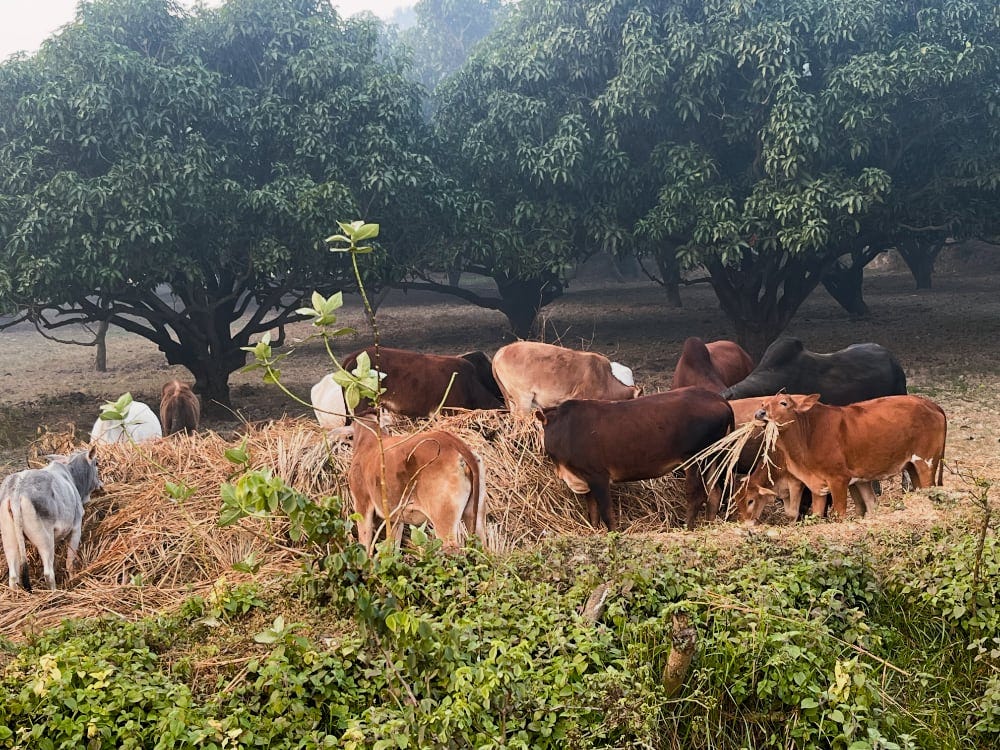
We’ve gone from sun shunners to sun worshippers inside of a month here in Uttar Pradesh.
You’ll see black buffalo lying in full sun, up against a wall, soaking up the weaker sun’s rays. The rest of the year? No way, sticking to the shade, baby!
I’ll leave you with some flying dogs, guaranteed to bring a smile to your face in any weather:
And if you haven’t viewed this newsletter on Substack yet, it’s a great big world out there!
Click on the title and then cruise around after you’ve read this issue. You’ll find thinking people, writers, doctors, independent reporters, comedians, photographers, sculptors, and artists of all stripes, and you can read views the Lame Stream Media would like to censor or deny.
Enjoy!
And let me know in the comments what’s your take on pet obesity, bird flu, how/where you source your and your animals’ food, and anything else on your mind.
Till next time,
Will Falconer, DVM





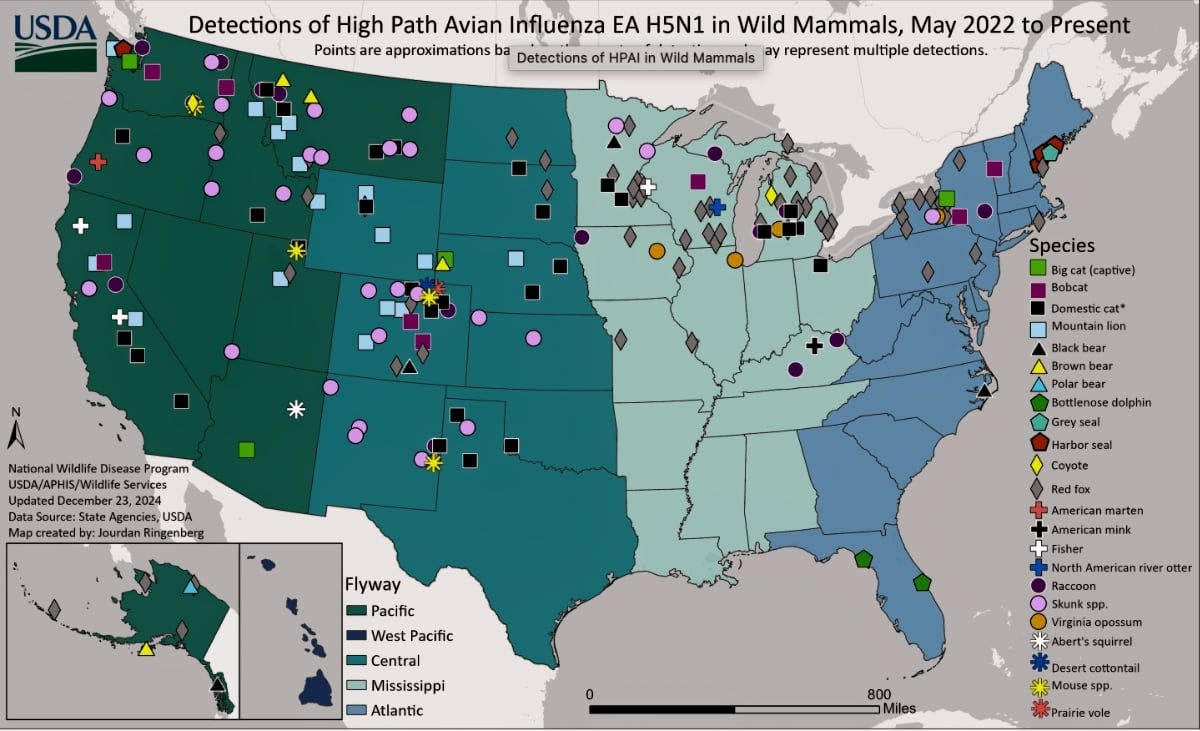




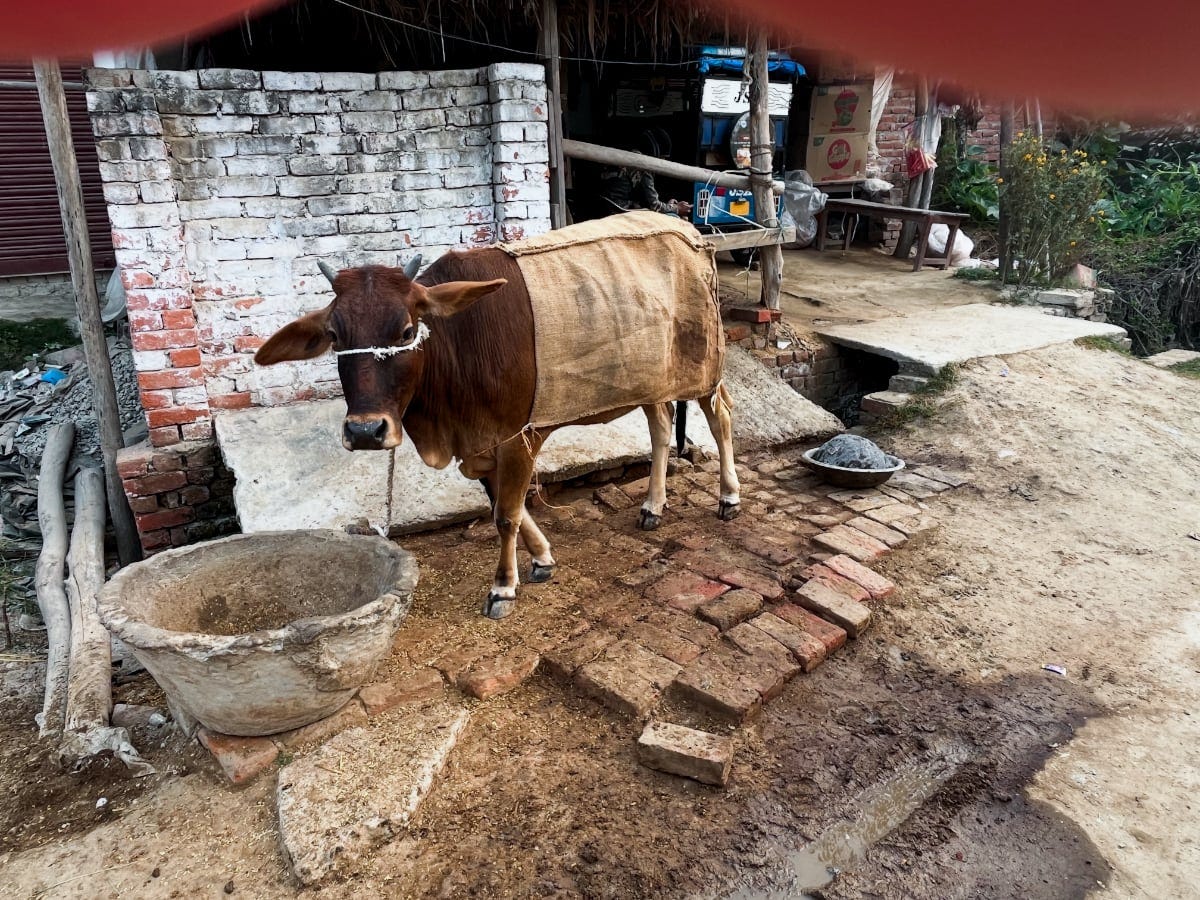
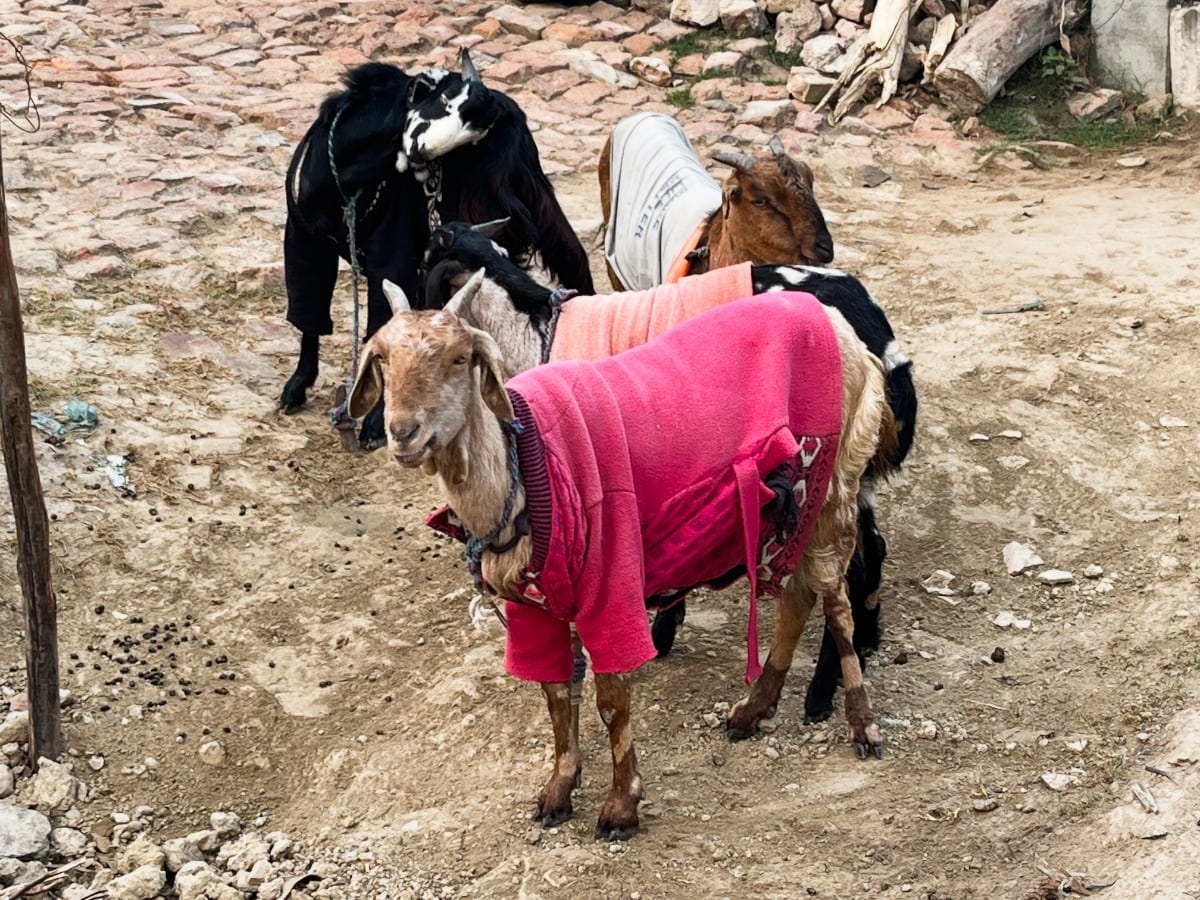

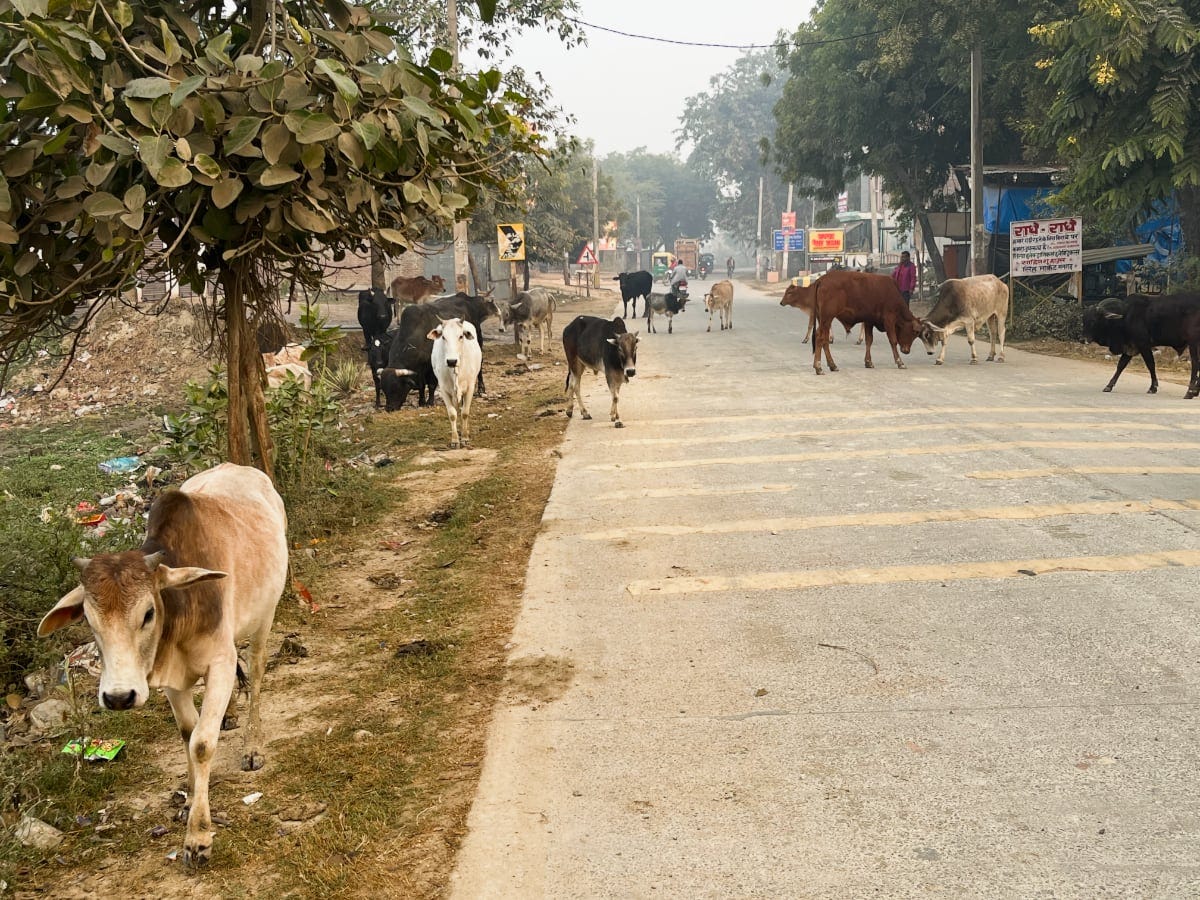

Thanks for the Cornucopia link. I'm not familiar with that yet. Looks like I may choose to switch the egg brand that I buy when the local farm market runs out of eggs, as they do this time of year.
I have two issues with the item on bird flu. The first one is ‘the data’. The data is always based on testing. ‘The animal tested positive for H5N1’. The tests are ALWAYS PCR tests. It has been irrefutably proven (and confirmed by its inventor) that you can use a PCR test to prove whatever you want as long as you run enough cycles. If we are ever going to get real answers we must, IMHO, completely eliminate PCR tests.
The second thing l struggle with is the recommendation to contact public health officials if your cat has certain symptoms because ‘these are also symptoms associated with rabies’. Involving ‘officials’ in this day and age will most likely result in your cat being subjected to a PCR test and being put down. Mind you, this recommendation is made by the AVMA, which is obviously a totally captured entity like the AMA, AHA and every other medical association out there. NOT criticism, Dr Falconer, but I’m often bewildered by your obvious understanding of the ‘disease’ and vaccine scams run by both human and animal medical establishments, and your reference to the data and recommendations of these same establishments.